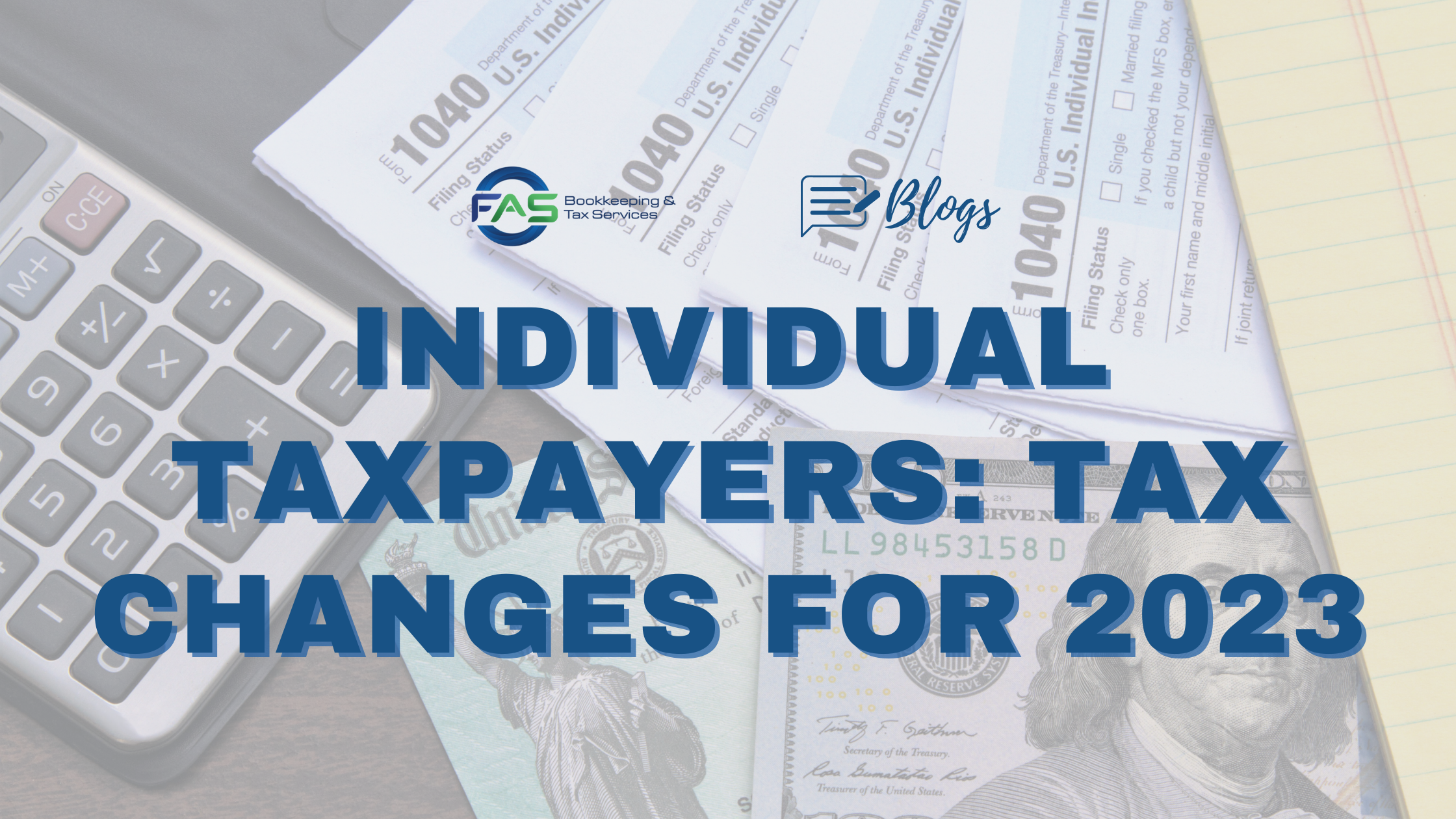Individual Taxpayers: Tax Changes for 2023
Every year, it’s a sure bet that there will be changes to current tax law, and this year is no different. From standard deductions to health savings accounts and tax rate schedules, here’s a checklist of tax changes for 2023 for individual taxpayers to help you plan the year ahead.
Individual Tax Changes
In 2023, a number of tax provisions are affected by inflation adjustments, including Health Savings Accounts, retirement contribution limits, and the foreign earned income exclusion. The tax rate structure, which ranges from 10 to 37 percent, remains similar to 2022; however, the tax bracket thresholds increase for each filing status. Standard deductions also rise, and as a reminder, personal exemptions have been eliminated through the tax year 2025.
Standard Deduction
In 2023, the standard deduction increases to $13,850 for individuals (up from $12,950 in 2022) and to $27,700 for married couples (up from $25,900 in 2022).
Alternative Minimum Tax (AMT)
In 2023, AMT exemption amounts increase to $81,300 for individuals (up from $75,900 in 2022) and $126,500 for married couples filing jointly (up from $118,100 in 2022). Also, the phaseout threshold increases to $578,150 ($1,156,300 for married filing jointly). Both the exemption and threshold amounts are indexed annually for inflation.
“Kiddie Tax”
For taxable years beginning in 2023, the amount that can be used to reduce the net unearned income reported on the child’s return that is subject to the “kiddie tax” is $1,250. The same $1,250 amount is used to determine whether a parent may elect to include a child’s gross income in the parent’s gross income and to calculate the “kiddie tax.” For example, one of the requirements for the parental election is that a child’s gross income for 2023 must be more than $1,250 but less than $12,500.
Health Savings Accounts (HSAs)
Contributions to a Health Savings Account (HSA) are used to pay the account owner’s current or future medical expenses, their spouse, and any qualified dependent. Medical expenses must not be reimbursable by insurance or other sources and do not qualify for the medical expense deduction on a federal income tax return.
A qualified individual must be covered by a High Deductible Health Plan (HDHP) and not be covered by other health insurance with the exception of insurance for accidents, disability, dental care, vision care, or long-term care.
For the calendar year 2023, a qualifying HDHP must have a deductible of at least $1,500 for self-only coverage or $3,000 for family coverage and must limit annual out-of-pocket expenses of the beneficiary to $7,500 for self-only coverage and $15,000 for family coverage.
Medical Savings Accounts (MSAs)
There are two types of Medical Savings Accounts (MSAs): The Archer MSA created to help self-employed individuals and employees of certain small employers, and the Medicare Advantage MSA, which is also an Archer MSA, and is designated by Medicare to be used solely to pay the qualified medical expenses of the account holder. To be eligible for a Medicare Advantage MSA, you must be enrolled in Medicare. Both MSAs require that you are enrolled in a high-deductible health plan (HDHP).
Self-only coverage. For taxable years beginning in 2023, the term “high deductible health plan” for self-only coverage means a health plan that has an annual deductible that is not less than $2,650 and not more than $3,950, and under which the annual out-of-pocket expenses required to be paid (other than for premiums) for covered benefits do not exceed $5,300.
Family coverage. For taxable years beginning in 2023, the term “high deductible health plan” means, for family coverage, a health plan that has an annual deductible that is not less than $5,300 and not more than $7,900, and under which the annual out-of-pocket expenses required to be paid (other than for premiums) for covered benefits do not exceed $9,650.
AGI Limit for Deductible Medical Expenses
In 2023, the deduction threshold for deductible medical expenses is 7.5 percent of adjusted gross income (AGI), made permanent by the Consolidated Appropriations Act, of 2022.
Eligible Long-Term Care Premiums
Premiums for long-term care are treated the same as health care premiums and are deductible on your taxes subject to certain limitations. For individuals age 40 or younger at the end of 2023, the limitation is $480. Persons more than 40 but not more than 50 can deduct $890. Those more than 50 but not more than 60 can deduct $1,790, while individuals more than 60 but not more than 70 can deduct $4,770. The maximum deduction is $5,960 and applies to anyone more than 70 years of age.
Medicare Taxes
The additional 0.9 percent Medicare tax on wages above $200,000 for individuals ($250,000 married filing jointly) remains in effect for 2023, as does the Medicare tax of 3.8 percent on investment (unearned) income for single taxpayers with modified adjusted gross income (AGI) more than $200,000 ($250,000 joint filers). Investment income includes dividends, interest, rents, royalties, gains from the disposition of property, and certain passive activity income. Estates, trusts, and self-employed individuals are all liable for the tax.
Foreign Earned Income Exclusion
For 2023, the foreign earned income exclusion amount is $120,000 up from $1112,000 in 2022.
Long-Term Capital Gains and Dividends
In 2023, tax rates on capital gains and dividends remain the same as 2022 rates (0%, 15%, and a top rate of 20%); however, threshold amounts have increased: the maximum zero percent rate amounts are $44,625 for individuals and $89,250 for married filing jointly. For an individual taxpayer whose income is at or above $492,300 ($553,850 married filing jointly), the rate for both capital gains and dividends is capped at 20 percent. All other taxpayers fall into the 15 percent rate amount (i.e., above $44,625 and below $492,300 for single filers).
Estate and Gift Taxes
For an estate of any decedent during the calendar year 2023, the basic exclusion amount is $12.92 million, indexed for inflation (up from $12.06 million in 2022). The maximum tax rate remains at 40 percent. The annual exclusion for gifts increases to $17,000.
Individual Tax Changes – Tax Credits
Adoption Credit
In 2023, a nonrefundable (only those individuals with tax liability will benefit) credit of up to $15,950 is available for qualified adoption expenses for each eligible child.
Earned Income Tax Credit
For tax year 2023, the maximum Earned Income Tax Credit (EITC) for low, and moderate-income workers and working families increases to $7,430 (up from $6,935 in 2022). The credit varies by family size, filing status, and other factors, with the maximum credit going to joint filers with three or more qualifying children.
Child Tax Credit
For 2023, the child tax credit is $2,000 per child, age 16 or younger. The refundable portion of the credit increases to $1,600 in 2023, so that even if taxpayers do not owe any tax, they can still claim the credit. A $500 nonrefundable credit is also available for dependents who do not qualify for the Child Tax Credit (e.g., dependents age 17 and older).
Child and Dependent Care Tax Credit
If you pay someone to take care of your dependent (defined as being under the age of 13 at the end of the tax year or incapable of self-care) to work or look for work, you may qualify for a credit of up to $1,050 or 35 percent of $3,000 of eligible expenses in 2023. For two or more qualifying dependents, you can claim up to 35 percent of $6,000 (or $2,100) of eligible expenses. For higher-income earners (AGI of $43,000 or more), the credit percentage is reduced, but not below 20 percent, regardless of the amount of adjusted gross income. This tax credit is nonrefundable.
Clean Vehicle Tax Credit
The Inflation Reduction Act makes several additional changes to the electric vehicle tax credit that will take effect starting January 1, 2023. Vehicles eligible for the Clean Vehicle Tax Credit now include both EVs (electric vehicles) and FCEVs (fuel cell electric vehicles) but must meet two requirements to be eligible for the tax credit. The critical minerals component refers to sourcing requirements for critical mineral extraction, processing, and recycling. The battery components requirement refers to vehicles that include a traction battery that has at least seven kilowatt-hours (kWh).
Vehicles that meet critical mineral requirements are eligible for a $3,750 tax credit, and vehicles that meet battery component requirements are eligible for a $3,750 tax credit. Vehicles meeting both requirements are eligible for a non-refundable tax credit of up to $7,500; however, there are additional requirements regarding manufacturer-suggested retail price (MSRP) thresholds for modified adjusted gross income (MAGI).
Individual Tax Changes – Education
American Opportunity Tax Credit and Lifetime Learning Credit
The maximum credit is $2,500 per student for the American Opportunity Tax Credit. The Lifetime Learning Credit remains at $2,000 per return. Both credits phase out for taxpayers with modified adjusted gross income between $80,000 and $90,000 (between $160,000 and $180,000 for joint filers). To claim the full credit for either, your modified adjusted gross income (MAGI) must be $80,000 or less ($160,000 or less for married filing jointly).
While the phaseout limits for Lifetime Learning Credit increased, taxpayers should note that the qualified tuition and expenses deduction was repealed starting in 2022.
Interest in Educational Loans
In 2023, the maximum deduction for interest paid on student loans is $2,500. The deduction begins to be phased out for higher-income taxpayers with modified adjusted gross income of more than $75,000 ($150,500 for joint filers) and is completely eliminated for taxpayers with modified adjusted gross income of $90,000 ($185,000 joint filers).
Individual – Retirement
Contribution Limits
The elective deferral (contribution) limit for employees who participate in 401(k), 403(b), most 457 plans, and the federal government’s Thrift Savings Plan increases to $22,500. Contribution limits for SIMPLE plans also increase to $15,500. The maximum compensation used to determine contributions increases to $330,000 (up from $305,000 in 2022).
Income Phase-out Ranges
The deduction for taxpayers making contributions to a traditional IRA is phased out for singles and heads of household who are covered by an employer-sponsored retirement plan and have modified AGI between $73,000 and $83,000.
For married couples filing jointly, in which the spouse who makes the IRA contribution is covered by an employer-sponsored retirement plan, the phase-out range increases to $116,000 and $136,000. For an IRA contributor who is not covered by an employer-sponsored retirement plan and is married to someone who is covered, the deduction is phased out if the couple’s modified AGI is between $218,000 and $228,000.
The modified AGI phase-out range for taxpayers making contributions to a Roth IRA is $138,000 and $153,000 for singles and heads of household, up from $129,000 to $144,000. For married couples filing jointly, the income phase-out range is $218,000 and $228,000, up from $204,000 to $214,000. The phase-out range for a married individual filing a separate return who makes contributions to a Roth IRA is not subject to an annual cost-of-living adjustment and remains $0 to $10,000.
Saver’s Credit
In 2023, the AGI limit for the Saver’s Credit (also known as the Retirement Savings Contribution Credit) for low and moderate-income workers is $73,000 for married couples filing jointly, up from $68,000 in 2022; $54,700 for heads of household, up from $51,000 in 2022; and $36,500 for singles and married individuals filing separately, up from $34,000 in 2022.





